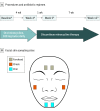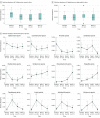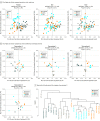Association of Systemic Antibiotic Treatment of Acne With Skin Microbiota Characteristics
- PMID: 30758497
- PMCID: PMC6459106
- DOI: 10.1001/jamadermatol.2018.5221
Association of Systemic Antibiotic Treatment of Acne With Skin Microbiota Characteristics
Abstract
Importance: Given the widespread use of systemic antibiotics for treatment of moderate to severe acne, it is important to understand the associations of such antibiotic use with changes not only in Cutibacterium acnes (formerly Propionibacterium acnes) but also in the complete bacterial community of the skin.
Objective: To examine the composition, diversity, and resilience of skin microbiota associated with systemic antibiotic perturbation in individuals with acne.
Design, setting, and participants: This longitudinal cohort study conducted at an academic referral center in Maryland from February 11 to September 23, 2014, included 4 female participants who had received a recent diagnosis of acne vulgaris, showed comedonal and inflammatory acne on the face, were at least 18 years old, and had no recent use of systemic or topical treatments for acne, including antibiotics and retinoids. Data analysis was performed between July 5, 2017, and November 7, 2018.
Interventions: Participants were prescribed oral minocycline, 100 mg, twice daily for 4 weeks. Skin areas on the forehead, cheek, and chin were sampled for 16S ribosomal RNA gene sequencing at baseline, 4 weeks after starting minocycline treatment, and then 1 week and 8 weeks after discontinuation of treatment.
Main outcomes and measures: Skin microbiota examined with respect to relative abundance of bacterial taxa, α diversity (represents within-sample microbial diversity), and β diversity (represents between-sample microbial diversity). Acne status evaluated with photography and lesion count.
Results: Of the 4 patients included in this study, 2 were 25 years old, 1 was 29 years old, and 1 was 35 years old; 2 were white women, 1 was an African American woman, and 1 was an Asian woman. Across all 4 patients, antibiotic treatment was associated with a 1.4-fold reduction in the level of C acnes (difference, -10.3%; 95% CI, -19.9% to -0.7%; P = .04) with recovery following cessation of treatment. Distinct patterns of change were identified in multiple bacterial genera, including a transient 5.6-fold increase in the relative abundance of Pseudomonas species (difference, 2.2%; 95% CI, 0.9%-3.4%; P < .001) immediately following antibiotic treatment, as well as a persistent 1.7-fold increase in the relative abundance of Streptococcus species (difference, 5.4%; 95% CI, 0.3%-10.6%; P = .04) and a 4.7-fold decrease in the relative abundance of Lactobacillus species (difference, -0.8%; 95% CI, -1.4% to -0.2%; P = .02) 8 weeks following antibiotic treatment withdrawal. In general, antibiotic administration was associated with an initial decrease from baseline of bacterial diversity followed by recovery. Principal coordinates analysis results showed moderate clustering of samples by patient (analysis of similarity, R = 0.424; P = .001) and significant clustering of samples by time in one participant (analysis of similarity, R = 0.733; P = .001).
Conclusions and relevance: In this study, systemic antibiotic treatment of acne was associated with changes in the composition and diversity of skin microbiota, with variable rates of recovery across individual patients and parallel changes in specific bacterial populations. Understanding the association between systemic antibiotic use and skin microbiota may help clinicians decrease the likelihood of skin comorbidities related to microbial dysbiosis.
Conflict of interest statement
Figures




Comment in
-
Antibiotics for Acne-A Pilot Study of Collateral Damage to the Skin Microbiome.JAMA Dermatol. 2019 Apr 1;155(4):419-421. doi: 10.1001/jamadermatol.2018.5146. JAMA Dermatol. 2019. PMID: 30758480 No abstract available.
Similar articles
-
Characterization and Analysis of the Skin Microbiota in Acne: Impact of Systemic Antibiotics.J Clin Med. 2020 Jan 8;9(1):168. doi: 10.3390/jcm9010168. J Clin Med. 2020. PMID: 31936262 Free PMC article.
-
Randomised controlled multiple treatment comparison to provide a cost-effectiveness rationale for the selection of antimicrobial therapy in acne.Health Technol Assess. 2005 Jan;9(1):iii-212. doi: 10.3310/hta9010. Health Technol Assess. 2005. PMID: 15588555 Clinical Trial.
-
Isotretinoin and lymecycline treatments modify the skin microbiota in acne.Exp Dermatol. 2018 Jan;27(1):30-36. doi: 10.1111/exd.13397. Epub 2017 Sep 14. Exp Dermatol. 2018. PMID: 28636791
-
Topical Minocycline Foam 4%: A Review in Acne Vulgaris.Am J Clin Dermatol. 2020 Jun;21(3):449-456. doi: 10.1007/s40257-020-00523-1. Am J Clin Dermatol. 2020. PMID: 32468355 Review.
-
The Skin Microbiome: A New Actor in Inflammatory Acne.Am J Clin Dermatol. 2020 Sep;21(Suppl 1):18-24. doi: 10.1007/s40257-020-00531-1. Am J Clin Dermatol. 2020. PMID: 32910436 Free PMC article. Review.
Cited by
-
The Impact of Acne Treatment on Skin Bacterial Microbiota: A Systematic Review.J Cutan Med Surg. 2022 Jan-Feb;26(1):93-97. doi: 10.1177/12034754211037994. Epub 2021 Aug 15. J Cutan Med Surg. 2022. PMID: 34396785 Free PMC article.
-
Minocycline and Its Impact on Microbial Dysbiosis in the Skin and Gastrointestinal Tract of Acne Patients.Ann Dermatol. 2020 Feb;32(1):21-30. doi: 10.5021/ad.2020.32.1.21. Epub 2020 Jan 9. Ann Dermatol. 2020. PMID: 33911705 Free PMC article.
-
Human Skin Microbiome: Impact of Intrinsic and Extrinsic Factors on Skin Microbiota.Microorganisms. 2021 Mar 5;9(3):543. doi: 10.3390/microorganisms9030543. Microorganisms. 2021. PMID: 33808031 Free PMC article. Review.
-
Identification of a Human Skin Commensal Bacterium that Selectively Kills Cutibacterium acnes.J Invest Dermatol. 2020 Aug;140(8):1619-1628.e2. doi: 10.1016/j.jid.2019.12.026. Epub 2020 Jan 23. J Invest Dermatol. 2020. PMID: 31981578 Free PMC article.
-
Skin-associated commensal microorganisms and their metabolites.J Appl Microbiol. 2025 May 2;136(5):lxaf111. doi: 10.1093/jambio/lxaf111. Epub 2025 May 7. J Appl Microbiol. 2025. PMID: 40402851 Review.
References
-
- Scholz CF, Kilian M. The natural history of cutaneous propionibacteria, and reclassification of selected species within the genus Propionibacterium to the proposed novel genera Acidipropionibacterium gen. nov., Cutibacterium gen. nov. and Pseudopropionibacterium gen. nov. Int J Syst Evol Microbiol. 2016;66(11):4422-4432. doi:10.1099/ijsem.0.001367 - DOI - PubMed
Publication types
MeSH terms
Substances
Grants and funding
LinkOut - more resources
Full Text Sources
Other Literature Sources
Medical

